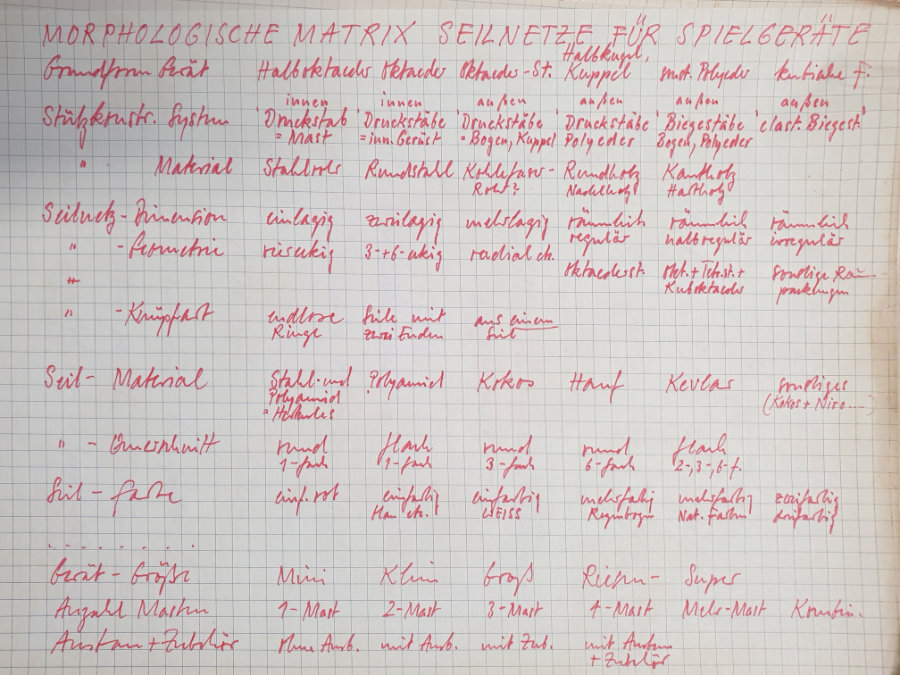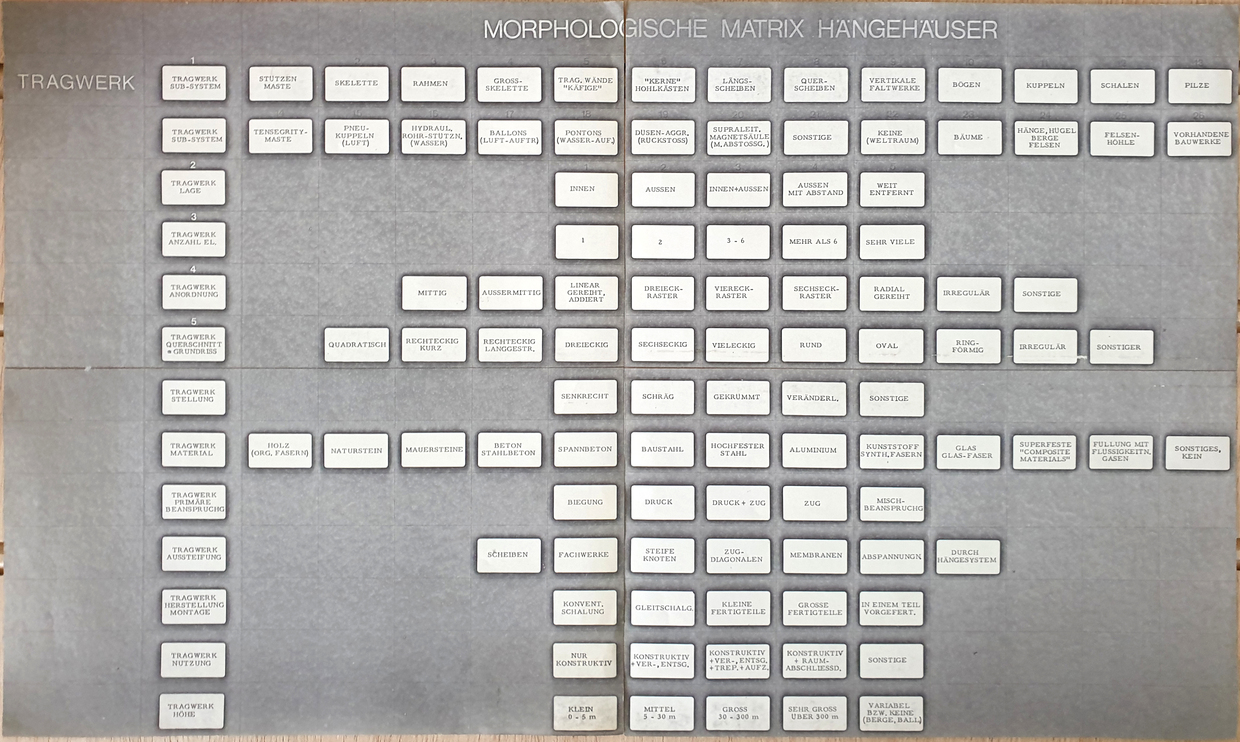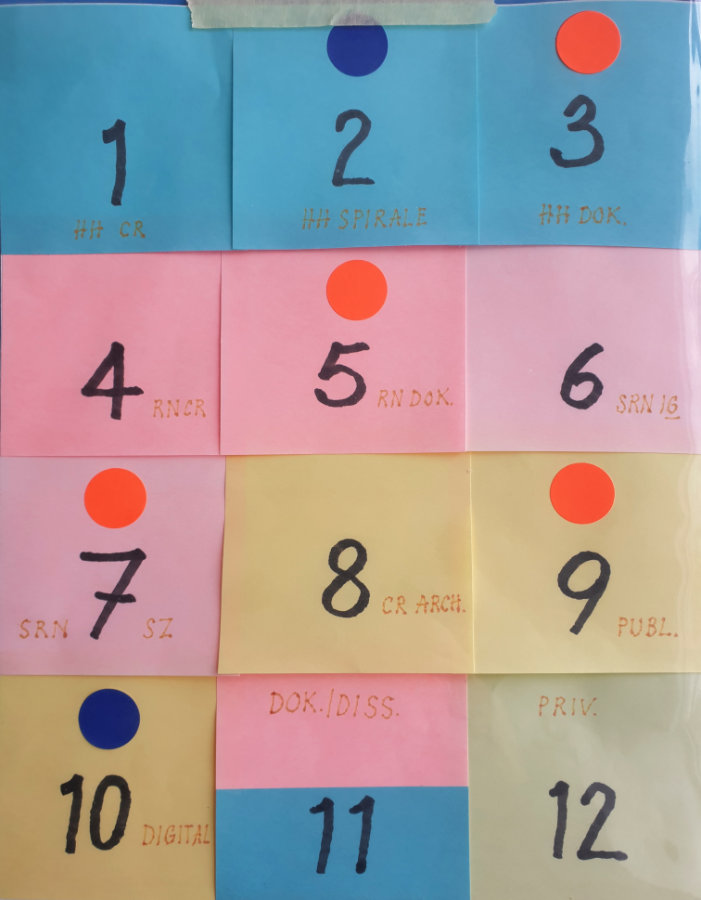Organisational System *02
How does one approach a legacy whose organisation does not follow any external system, but instead reflects the creative thinking of its originator? How can one catalogue a collection that itself forms a complex ordering system – colour-coded, interconnected, and openly structured? And what does it mean when a legacy is not arranged chronologically, but is built upon concepts and intellectual connections?
These questions lie at the heart of engaging with the legacy of Conrad Roland. The architect and designer, renowned for his cable net structures and visionary designs, embedded a multilayered and overlapping organisational system within his body of work and research – consisting of coloured markings, handwritten matrices, and self-defined categories. Since 2024, his legacy has been jointly catalogued by the Wüstenrot Foundation and the saai | Archive for Architecture and Civil Engineering as part of the project Werkarchiv Conrad Roland - Suspended Houses, Spacenets and the Categorisation of Architectural Knowledge. The challenge lies in reconciling Roland’s conceptual structure with archival standards – without undermining its internal logic.

Conrad Roland was fascinated by the so-called Zwicky Box—a method developed by Swiss astrophysicist Fritz Zwicky that breaks down complex problems into their components and systematically explores new combinations. Roland used these morphological matrices both to structure complex constructive systems in his research and to explore more straightforward topics, such as developing different cable-net typologies for playgrounds.
Thematic Clusters Instead of Project Chronology
Traditional architectural legacies are usually structured by project and therefore mostly chronologically. However, this approach proves inadequate in the case of Conrad Roland’s legacy: many of his designs evolved over years, were recombined, rethought, or transferred into new contexts. His own ideas became interwoven with the work of other architects, whom Roland incorporated into his research; theoretical concepts found their way into built projects – and vice versa. For this reason, the decision was made to deviate from the conventional project-based structure and instead adopt a thematic approach. This thematic clustering takes into account both the heterogeneity of the materials and Roland’s open, process-driven working method. It allows related materials to be grouped by content – regardless of their date of origin or degree of completion.
Original packaging, labels, and enclosures are also systematically recorded. These seemingly peripheral elements often provide crucial insights into contexts of use, earlier systems of organisation, and thematic relationships – and are thus key to a deeper understanding of the legacy.
At present, the collection is divided into seven thematic clusters, which may be reviewed, adapted or expanded over time:
1. Family and Networks
2. Schooling and Education
3. Housing Visions and Suspension Structures
4. Play Nets and Rope Constructions
5. Research and Mediation
6. Systematics and Methodology
7. Emigration and Paradise Project
Dynamic Reference Code Assignment for a Step-by-Step Approach
The unique nature of Roland’s legacy also requires a flexible approach to reference code assignment. Since the work follows a colour-coded and content-driven logic, a rigid numbering system was deliberately avoided. Instead, reference codes are assigned dynamically: each thematic cluster is given a three-digit identifier, which can be expanded down to the level of individual documents as needed. This ensures that the thematic context of each material group remains traceable – even if physical repackaging becomes necessary. Where materials could be allocated to more than one cluster or do not clearly fit into any existing category, individual assessment is carried out – tailored to the complexity of the respective context.
This process preserves not only external order, but also the methodological dimension of the legacy: Roland’s colour codes and classifications were not merely filing tools, but tools for thought. They helped him to establish connections, identify relationships, and develop ideas further. For archival work, this means that external order is inseparably linked to conceptual understanding – and therefore essential to appropriate cataloguing.
Research Potential and Conceptual Contextualisation
Roland’s system is closely linked to his creative and theoretical ambition to understand architecture as networked, systematic thinking. A key role was played by the so-called Zwicky Box – a method developed by Swiss astrophysicist Fritz Zwicky for structured problem analysis. Using this “morphological matrix”, Roland broke down complex topics into their constituent elements, recombined them, and developed innovative approaches to design and research.
The matrices he created were far more than just sorting aids. They were instruments for visualising relationships between space, function, material and use – across building types and scales. For example, playful spatial experiments could be linked with large-scale constructions, or furniture studies with urban planning concepts.
Audiovisual Access as an Extension of the Archive
To document this conceptual space as comprehensively as possible, supplementary forms of knowledge are integrated that go beyond traditional archival objects. Many connections only become visible through the lived experience of people who accompanied Roland professionally or privately. For this reason, interviews were conducted with family members, colleagues and close companions. Their perspectives enable more precise contextualisation of individual projects and help reconstruct thematic interrelations. Evaluation is carried out gradually, with close attention to content and full respect for personal privacy.
Additionally, the construction of selected cable net structures is being documented on film and in photographs. The focus lies on technical details, material behaviour, and specific working techniques – aspects that cannot easily be derived from drawings or written records alone. In this way, the archive is expanded to include embodied knowledge that would otherwise risk being lost.
Perspectives for a Dynamic Archival Practice
The cataloguing of Conrad Roland’s legacy stands as an example of an archival practice that brings together traditional systems of order with dynamic, digital, and process-oriented formats. The use of thematic clusters, flexible reference code assignment, and the integration of complementary knowledge sources opens new pathways for contextualisation – requiring a careful balance between structure and openness.
This is not merely a matter of accessibility or preservation, but of recognising the legacy as a space of thought – a site of creative inquiry, theoretical reflection, and interdisciplinary engagement.
MG, 20.7.2025



